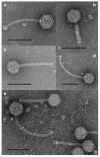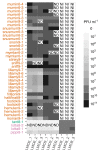Diversity and Host Interactions Among Virulent and Temperate Baltic Sea Flavobacterium Phages
- PMID: 32019073
- PMCID: PMC7077304
- DOI: 10.3390/v12020158
Diversity and Host Interactions Among Virulent and Temperate Baltic Sea Flavobacterium Phages
Abstract
Viruses in aquatic environments play a key role in microbial population dynamics and nutrient cycling. In particular, bacteria of the phylum Bacteriodetes are known to participate in recycling algal blooms. Studies of phage-host interactions involving this phylum are hence important to understand the processes shaping bacterial and viral communities in the ocean as well as nutrient cycling. In this study, we isolated and sequenced three strains of flavobacteria-LMO6, LMO9, LMO8-and 38 virulent phages infecting them. These phages represent 15 species, occupying three novel genera. Additionally, one temperate phage was induced from LMO6 and was found to be competent at infecting LMO9. Functions could be predicted for a limited number of phage genes, mainly representing roles in DNA replication and virus particle formation. No metabolic genes were detected. While the phages isolated on LMO8 could infect all three bacterial strains, the LMO6 and LMO9 phages could not infect LMO8. Of the phages isolated on LMO9, several showed a host-derived reduced efficiency of plating on LMO6, potentially due to differences in DNA methyltransferase genes. Overall, these phage-host systems contribute novel genetic information to our sequence databases and present valuable tools for the study of both virulent and temperate phages.
Keywords: aquatic; genomics; host range; lysogeny; lytic.
Conflict of interest statement
The authors declare no conflict of interest.
Figures







References
Publication types
MeSH terms
Substances
Grants and funding
LinkOut - more resources
Full Text Sources

